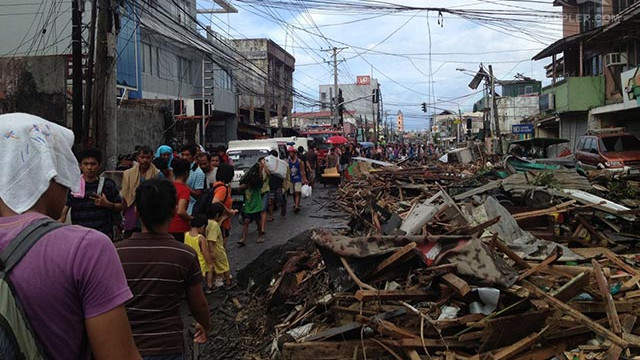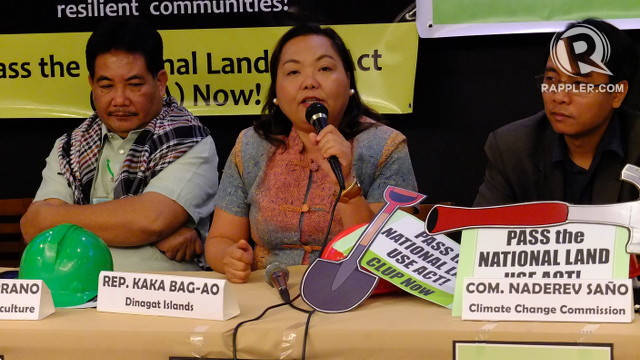SUMMARY
This is AI generated summarization, which may have errors. For context, always refer to the full article.

MANILA, Philippines – Those to blame for the staggering scale of devastation wrought by Super Typhoon Yolanda (Haiyan) are the lawmakers who failed to pass the National Land Use Act (NLUA).
These were the words of Rico Cajife, a young man who survived Yolanda’s wrath in Tacloban.
While the terror and panic are now mere memories, his anger is fresh and raw as he tells media during a December 4 press conference that if the NLUA had only been passed years ago, loss of life and damage to houses and infrastructure would have been much less.
“Dahil walang National Land Use Act, maraming bahay ang nakatayo malapit sa dagat. Sixty percent ng mga bahay sa Tacloban malapit sa coastline. Pati yung evacuation center malapit sa dagat kaya naabutan ng mataas na baha,” he said.
(Because there is no NLUA, lots of houses were standing near the sea. 60% of houses in Tacloban are near the coastline. Even the evacuation center is near the sea so high floods reached it.)
His voice joined many others who called on Congress to make the passage of the NLUA a priority. Public officials, environmentalists, land use experts, farmers and fisherfolk urged President Benigno Aquino III to certify the bill as urgent, a welcome follow-up to his first State of the Nation Address in 2010 when he underscored the need to pass the measure.
“I believe this should be the first law passed by Congress,” said Representative Kaka Bag-ao who filed the NLUA or House Bill 108. “There are more storms coming and we need to prepare our countrymen for them.”
The NLUA, once passed, mandates that the national and local governments work together to determine how land is to be used. Specifically, it orders the government to classify land into 4 types of use:
- Protected Land Use – Using land to maintain ecological and life-support systems. This includes protected areas like forest and aquatic ecosystems and watersheds
- Production Land Use – Using land to generate goods, resources or services like in agriculture, fish farming or aquaculture, timber or other forest products, grazing, pasture, mining, energy resources and tourism
- Settlements Development – Using land as places of human dwelling like for subdivisions, condominiums and housing
- Infrastructure Land Use – Using land for providing basic services that promote economic and societal growth like for roads, transportation facilities, communication facilities, social services and utilities
The bill, in its many forms, has languished in Congress for more than 20 years. Its recent version, the bill filed by Bag-ao, passed the committee level and is on its way to second reading in the House of Representatives.
As far as she knows, the Senate Committee on the Environment and Natural Resources under Senator Loren Legarda has not yet taken up the proposed measure.
A matter of survival
Having a national land use policy can spell the difference between life and death during extreme weather events like storms.
During Tropical Storm Ondoy, communities in lower Marikina City were heavily flooded and sustained serious infrastructure damage.
Why were the floods so high that year? Satellite photos of Upper Marikina showed that over the years, the forest cover was greatly reduced because the forest lands were converted into agricultural lands.
Land use expert Dr Elmer Mercado said that 4,500 hectares of forest were converted from 2003 to 2010 in Upper Marikina towns like Rodriguez, San Mateo, and Antipolo.
Because there were no trees to absorb the rushing water brought by Ondoy, Lower Marikina was inundated as it had never been before.
A national land use policy is the most sustainable, long-term preparation for climate change, said Climate Change Commissioner Naderev “Yeb” Saño. (READ: ‘Stop this climate crisis madness’)
It forces government officials to rethink where they will put settlements, agricultural land, and commercial developments, taking into consideration climate change impacts like more frequent storm surges, typhoons, droughts and heatwaves.
Out of all developing countries, the Philippines is the only one lacking a national land use policy, said Department of Agriculture Undersecretary Fred Serrano.
This has resulted in haphazard urban and rural planning, and uncontrolled conversion of lands into other uses. For example, primary agricultural land identified by the DA continues to be converted into real estate developments ultimately threatening food security and the agricultural sector.
“Land is a very important resource since it is our main source of food, settlements and biodiversity. Sustainable and genuine national development can only come from proper land use planning,” he explained.
If the NLUA is passed, land identified as primary agricultural land can never be converted. This ensures land for farmers and gives the country a shot at being self-sufficient in such essential crops as rice, corn, potato, and vegetables.
Obstacles
So why has the NLUA not been passed?
Bag-ao said even after more than 20 years in and out of Congress, legislators still can’t seem to get a firm grasp on the issue.
“Until now, there are still many members of House that tell me they need to talk about it. But I tell them, what will we talk about? How many cartoon magazines, how many primers have been released? There’s already an ‘idiot’s guide’ to land use. But why do they still want to debate on it?”
Some legislators have argued there is no need for a national policy since LGUs implement their own land use planning already.
But Bag-ao doesn’t think this is enough. In fact, putting matters in the hands of LGU officials has made land use planning rather “whimsical.”
“For example, when an investor comes along looking for a place to build a subdivision and he sees a place with a nice view, the land use plan adjusts. [The officials] will change the land use plan so that the ordinance says that houses can be built there,” she explained in Filipino.
Under the NLUA, such a thing would not be possible. There will be stricter, clear-cut measures and a National Land Use Policy Council on the local and national level that will oversee the process.
The “no-build-zones” currently being implemented in Yolanda-hit localities are mere suggestions which LGU officials can brush off. A national law would put more force on the need to prohibit structures in geohazard or high-risk areas. (READ: MGB allots P400M for completion of geohazard maps by 2014)
A national land use policy will also force LGU officials to frame local concerns in a national context. Officials will have to assess how their land use planning will affect other LGUs and ultimately the entire country.
There is no more time to fight over the NLUA, said Saño.
The bill was almost passed by the Senate in the last Congress but two days before the session closed, questions were raised, thereby blocking it.
“Hindi na pwede yung basta-basta, kanya-kanya. Nakapaiksi ng oras. Tapos na ang debate. Tapos na ang argumento.”
(To each his own won’t cut it anymore. Time is short. The debate is over. The arguments are over.) – Rappler.com
Add a comment
How does this make you feel?

There are no comments yet. Add your comment to start the conversation.